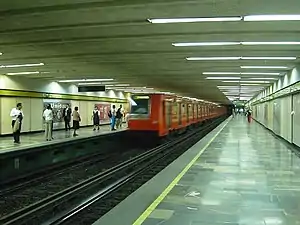| Line 3 / Línea 3 | |
|---|---|
 | |
| Overview | |
| Locale | Mexico City |
| Termini | |
| Connecting lines | |
| Stations | 21 |
| Service | |
| Type | Rapid transit |
| System | Mexico City Metro |
| Operator(s) | Sistema de Transporte Colectivo (STC) |
| Rolling stock | NM-79, NM-83A, NE-92 |
| Ridership | 609,228 passengers per day (2019)[1] |
| History | |
| Opened | 20 November 1970 |
| Technical | |
| Line length | 21.278 km (13 mi) |
| Track length | 23.609 km (15 mi) |
| Number of tracks | 2 |
| Track gauge | 1,435 mm (4 ft 8+1⁄2 in) standard gauge with roll ways along track |
| Electrification | Guide bars |
| Operating speed | 36 km/h (22 mph) |
Mexico City Metro Line 3 is one of the 12 metro lines built in Mexico City, Mexico.[2][3]
Line 3 is the longest line, its color is olive green and it runs from north to south of the city covering almost all of it.
It is built under Avenida de los Insurgentes, Guerrero, Zarco, Balderas, Cuauhtémoc, Universidad, Copilco and Delfín Madrigal avenues. It interchanges with Line 6 at Deportivo 18 de Marzo, Line 5 at La Raza, Line B at Guerrero, Line 2 at Hidalgo, Line 1 at Balderas, Line 9 at Centro Médico. and Line 12 at Zapata.[4][5]
Chronology
- 20 November 1970: from Tlatelolco to Hospital General[6]
- 25 August 1978: from Tlatelolco to La Raza[6]
- 1 December 1979: from La Raza to Indios Verdes[6]
- 7 June 1980: from Hospital General to Centro Médico[6]
- 25 August 1980: from Centro Médico to Zapata[6]
- 30 August 1983: from Zapata to Universidad[6]
Rolling stock
Line 3 has had different types of rolling stock throughout the years.
- Alstom MP-68: 1970–1981
- Concarril NM-73: 1978–1981
- Concarril NM-79 1982–present
- Alstom MP-82 1985–1994
- Concarril NM-83 1990–present
- Bombardier NC-82: 2004–2012
- CAF NE-92, 2023–present
The NM-79 trains were made in Mexico in 1979 by Concarril and the NM-83A trains were made in México by Concarril between 1983 and 1991.
Currently, out of the 390 trains in the Mexico City Metro network, 50 are in service in Line 3, more than in any other line.[7]
Station list
| Denotes a partially accessible station | |
| Denotes a fully accessible station | |
| Denotes a metro transfer | |
| Denotes a connection with the Cablebús system | |
| Denotes a connection with the Centro de transferencia modal (CETRAM) system | |
| Denotes a connection with the Ecobici system | |
| Denotes a connection with the Metrobús system | |
| Denotes a connection with the Mexibús system | |
| Denotes a connection with the Mexicable system | |
| Denotes a connection with the public bus system | |
| Denotes a connection with the Red de Transporte de Pasajeros (RTP) system | |
| Denotes a connection with the Trolleybus system |
The stations from north to south:


| No. | Station | Date opened | Level | Distance (km) | Connection | Location | |
|---|---|---|---|---|---|---|---|
| Between stations |
Total | ||||||
| 01 | Indios Verdes |
December 1, 1979 | Ground-level, underground access |
- | 0.0 |
|
Gustavo A. Madero |
| 02 | Deportivo 18 de Marzo |
1.3 | 1.3 |
| |||
| 03 | Potrero |
1.1 | 2.4 |
| |||
| 04 | La Raza |
August 25, 1978 | Underground, trench |
1.2 | 3.6 |
| |
| 05 | Tlatelolco | November 20, 1970 | 1.6 | 5.2 |
|
Cuauhtémoc | |
| 06 | Guerrero |
1.1 | 6.3 |
| |||
| 07 | Hidalgo |
Underground, trench (Lv. -2) |
0.9 | 7.2 |
| ||
| 08 | Juárez |
Underground, trench |
0.4 | 7.6 |
| ||
| 09 | Balderas |
Underground, trench (Lv. -2) |
0.7 | 8.4 |
| ||
| 10 | Niños Héroes / Poder Judicial CDMX |
Underground trench |
0.8 | 9.2 |
| ||
| 11 | Hospital General |
0.8 | 9.9 |
| |||
| 12 | Centro Médico |
June 7, 1980 | 0.8 | 10.7 |
| ||
| 13 | Etiopía / Plaza de la Transparencia |
August 25, 1980 | 1.5 | 12.3 |
|
Benito Juárez | |
| 14 | Eugenia | 1.0 | 13.3 |
| |||
| 15 | División del Norte | 0.8 | 14.1 |
| |||
| 16 | Zapata |
1.0 | 15.1 |
| |||
| 17 | Coyoacán | August 30, 1983 | Underground deep trench |
1.2 | 16.4 |
| |
| 18 | Viveros / Derechos Humanos |
Underground double tunnel |
1.0 | 17.4 |
|
Coyoacán | |
| 19 | Miguel Ángel de Quevedo |
1.0 | 18.4 |
| |||
| 20 | Copilco |
Underground deep trench |
1.4 | 19.8 |
| ||
| 21 | Universidad |
Ground-level, overground access | 1.5 | 21.3 |
| ||
Renamed stations
| Date | Old name | New name |
|---|---|---|
| 1998 | Basílica | Deportivo 18 de Marzo |
| 2009 | Etiopía | Etiopía / Plaza de la Transparencia |
| 2009 | Viveros | Viveros / Derechos Humanos |
| 2019 | Niños Héroes | Niños Héroes / Poder Judicial CDMX |
Ridership
The following table shows each of Line 3 stations total and average daily ridership during 2019.[1]
| † | Transfer station |
| ‡ | Terminal |
| Rank | Station | Total ridership | Average daily |
|---|---|---|---|
| 1 | Indios Verdes‡ | 39,192,273 | 107,376 |
| 2 | Universidad‡ | 26,555,624 | 72,755 |
| 3 | Copilco | 14,030,121 | 38,439 |
| 4 | Deportivo 18 de Marzo† | 12,397,054 | 33,965 |
| 5 | Miguel Ángel de Quevedo | 12,101,570 | 33,155 |
| 6 | La Raza† | 11,364,171 | 31,135 |
| 7 | Etiopía / Plaza de la Transparencia | 10,885,701 | 29,824 |
| 8 | Coyoacán | 9,780,261 | 26,795 |
| 9 | Zapata† | 9,027,192 | 24,732 |
| 10 | Niños Héroes / Poder Judicial CDMX | 7,865,930 | 21,550 |
| 11 | Viveros / Derechos Humanos | 7,727,513 | 21,171 |
| 12 | Tlatelolco | 7,562,593 | 20,719 |
| 13 | Hospital General | 7,478,953 | 20,490 |
| 14 | Centro Médico† | 7,395,505 | 20,262 |
| 15 | Eugenia | 6,700,579 | 18,358 |
| 16 | División del Norte | 6,552,063 | 17,951 |
| 17 | Hidalgo† | 6,378,926 | 17,477 |
| 18 | Juárez | 6,320,737 | 17,317 |
| 19 | Potrero | 6,317,545 | 17,308 |
| 20 | Guerrero† | 3,893,901 | 10,668 |
| 21 | Balderas† | 2,840,045 | 7,781 |
| Total | 222,368,257 | 609,228 | |
Tourism
Line 3 passes near several places of interest:
- Plaza de las Tres Culturas, square in the Tlatelolco neighborhood.
- Historic center of Mexico City
- Ciudad Universitaria, the main campus of the National Autonomous University of Mexico
See also
Notes
- ↑ The following list was adapted from different websites and official maps.
- Metro (
_version_2019.svg.png.webp) ) connections obtained from the official Mexico City Metro system map.[8]
) connections obtained from the official Mexico City Metro system map.[8] - Accessibility obtained from the Mexico City Metro system map. In some cases, the map omits the accessibility icon as the station(s) are actually partially accessible. However, the respective websites of each station on the official site indicate the respective accessibility methods. Stations with the symbol
 ‡ are fully accessible; stations with the symbol
‡ are fully accessible; stations with the symbol  † are partially accessible.[8]
† are partially accessible.[8] - Cablebús (
 ) obtained from their official website.[9]
) obtained from their official website.[9] - Centro de transferencia modal (CETRAM;
_%C3%93rgano_Regulador_de_Transporte_(CETRAM).svg.png.webp) ) obtained from the official website of the Órgano Regulador de Transporte.[10]
) obtained from the official website of the Órgano Regulador de Transporte.[10] - Ecobici (
_EcoBici.svg.png.webp) ) obtained from their official website.[11]
) obtained from their official website.[11] - Metrobús (
 ) obtained from the Mexico City Metrobús system map.[12]
) obtained from the Mexico City Metrobús system map.[12] - Mexibús (
.svg.png.webp) ) obtained from the official Mexico City Metro system map.[8]
) obtained from the official Mexico City Metro system map.[8] - Public buses network (peseros) (
_Red_de_Autobuses_de_la_CDMX.svg.png.webp) ) obtained from the official website of the Órgano Regulador de Transporte.[13]
) obtained from the official website of the Órgano Regulador de Transporte.[13] - Red de Transporte de Pasajeros (
 ) obtained from their official website.[14]
) obtained from their official website.[14] - Trolleybuses (
 ) obtained from their official website.[9]
) obtained from their official website.[9]
- Metro (
References
- 1 2 "Afluencia de estación por línea 2019" (in Spanish). Metro CDMX. Retrieved 27 April 2020.
- ↑ "Linea 3: Indios Verdes – Universidad" (in Spanish). Archived from the original on 8 August 2011. Retrieved 14 August 2011.
- ↑ Archambault, Richard. "Metro Line 3 » Mexico City Metro System". Retrieved 14 August 2011.
- ↑ "Linea 12; Linea Dorado; la Linea del Bicentenario" (in Spanish). Mexico City Metro. p. b. Archived from the original on 17 September 2011. Retrieved 14 August 2011.
- ↑ "Metro Line 12". Retrieved 14 August 2011.
- 1 2 3 4 5 6 Monroy, Marco. Schwandl, Robert (ed.). "Opening Dates for Mexico City's Subway". Retrieved 5 August 2011.
- ↑ "Parque vehicular" (in Spanish). Metro CDMX. Retrieved 27 April 2020.
- 1 2 3 "Mi Mapa Metro 22032021" [My Metro Map 22032021] (PDF) (in Spanish). Sistema Transporte Colectivo Metro. 22 March 2021. Retrieved 30 October 2021.
- 1 2 "Servicios" [Services] (in Spanish). Servicio de Transportes Eléctricos. Retrieved 30 October 2021.
- ↑ "Centros de Transferencia Modal (CETRAM)" [Modal Transfer Centers] (in Spanish). Órgano Regulador de Transporte. Retrieved 30 October 2021.
- ↑ "Mapa de disponibilidad" [Disponibility map] (in Spanish). Ecobici. Retrieved 30 October 2021.
- ↑ "Mapa del sistema" [System map] (in Spanish). Mexico City Metrobús. Retrieved 30 October 2021.
- ↑ "Red de corredores" [Route network] (in Spanish). Retrieved 30 October 2021.
- ↑ "Red de Rutas" [Routes network] (in Spanish). Red de Transporte de Pasajeros. Retrieved 30 October 2021.